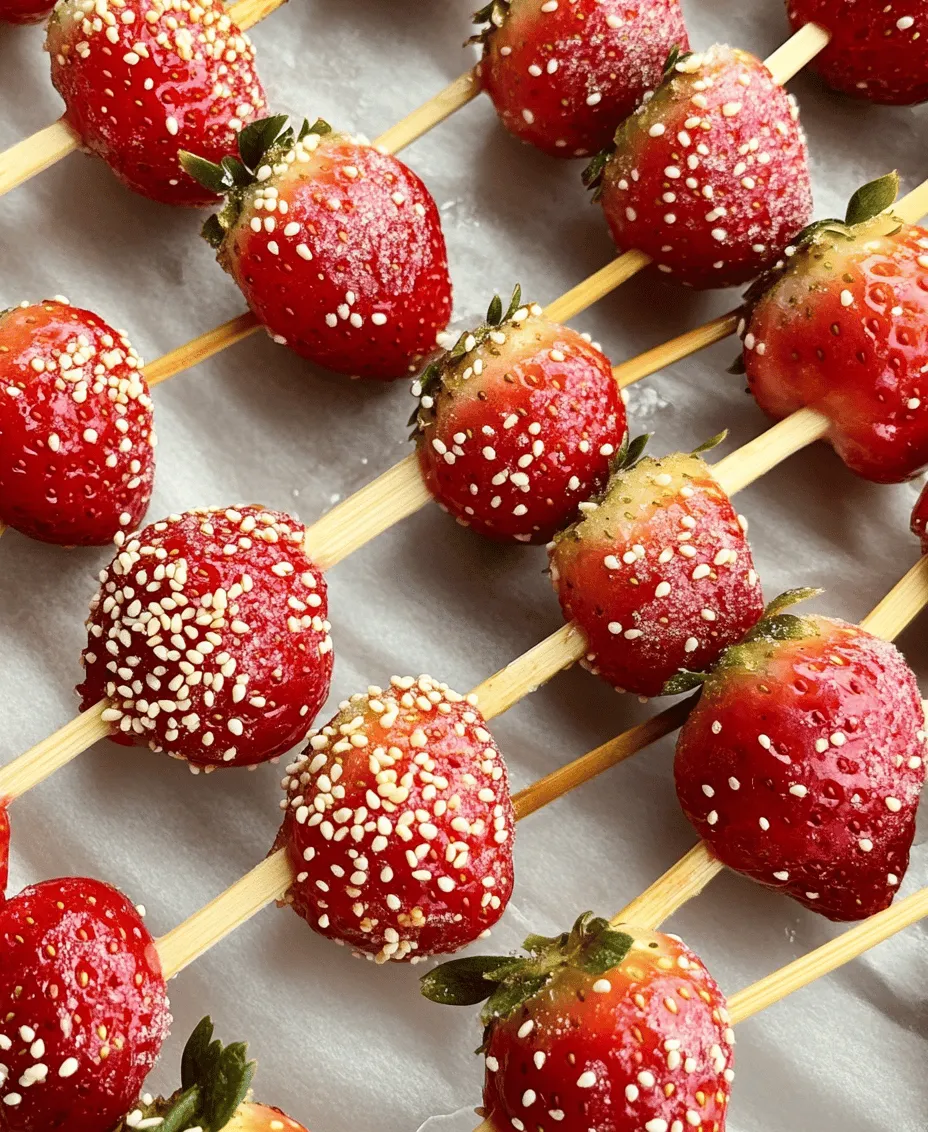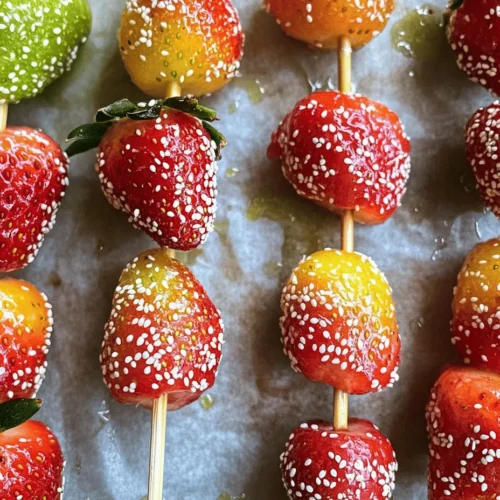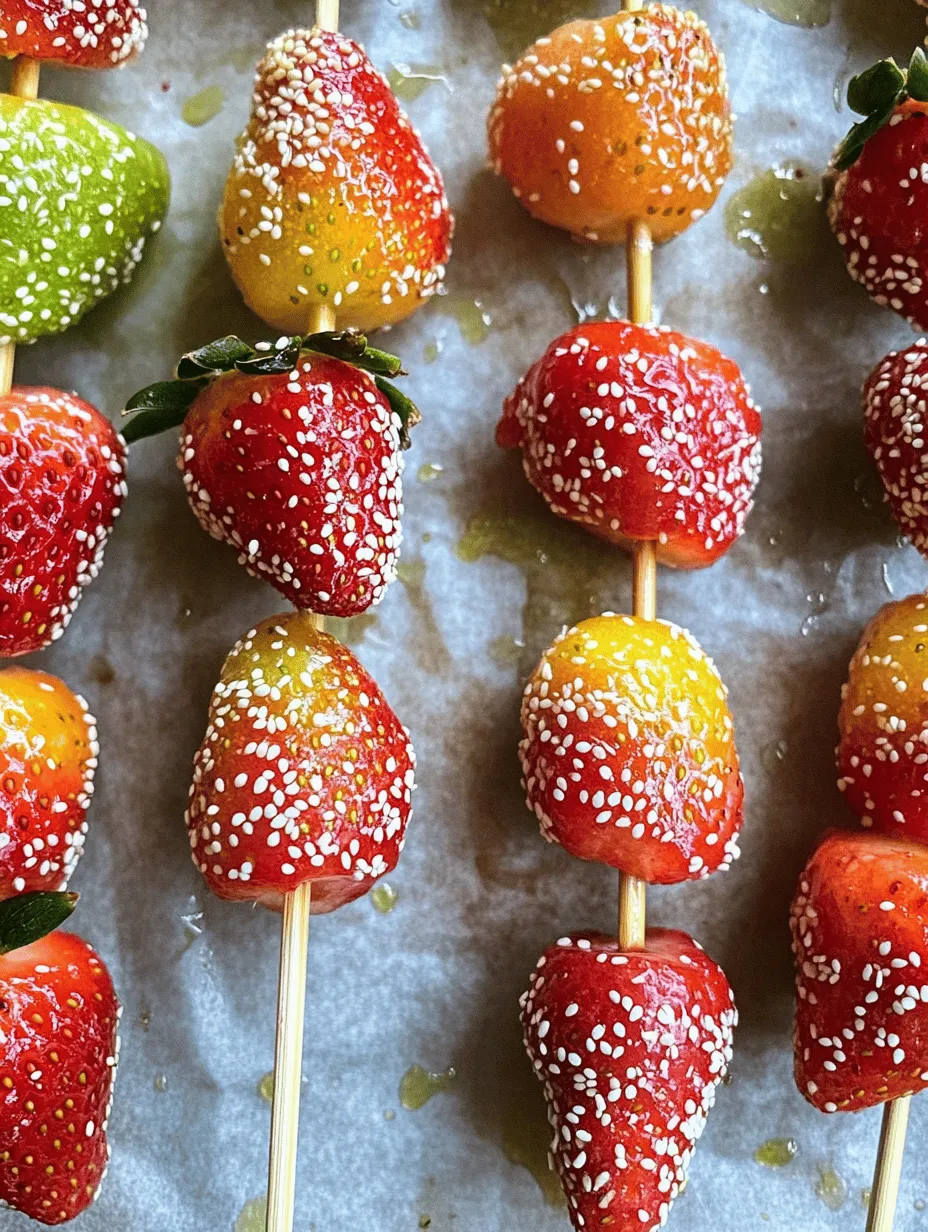Introduction
Tanghulu, also known as sugar-coated fruit skewers, is a delightful traditional Chinese snack that has gained popularity across the globe. Originating from the bustling streets of Beijing, this treat is not just a feast for the eyes but also a wonderful explosion of flavors. The combination of fresh, juicy fruits coated in a crunchy, sweet sugar shell creates a sensory experience that is hard to resist. Whether you are at a street fair in China or a local food festival anywhere else, the sight of vibrant fruit skewers glistening with sugar is sure to catch your attention.
What makes Tanghulu so appealing is its duality—the tartness of the fresh fruit beautifully contrasts with the sweetness of the candy coating. This balance makes it an enjoyable treat that can cater to a variety of tastes. Additionally, Tanghulu is a versatile snack that can be customized according to personal preference, making it perfect for parties, family gatherings, or simply as an indulgence at home. In this article, we’ll guide you through the process of making your very own Sweet and Tangy Tanghulu Delights.
Understanding Tanghulu
History of Tanghulu: Origins in Chinese Street Food
The history of Tanghulu can be traced back to ancient China, with the first documented references dating to the Song Dynasty (960-1279 AD). Initially, the dish was made using hawthorn berries, which were skewered and dipped in a sugar solution. This practice not only made the fruit more palatable but also served as a method of preservation. Over time, street vendors began to offer a variety of fruits dipped in sugar, leading to the diverse selection we see today.
As urbanization progressed, Tanghulu became a common sight at night markets and street fairs, where vendors would sell these vibrant snacks to hungry passersby. The art of making Tanghulu has been passed down through generations, and while the classic hawthorn berry remains a favorite, other fruits such as strawberries, grapes, and mandarin oranges have become popular choices.
Modern Variations and Global Adaptations
In recent years, Tanghulu has found its way into the hearts of food enthusiasts worldwide, leading to various adaptations that celebrate local ingredients and culinary preferences. In some regions, you may find Tanghulu made with tropical fruits like pineapple or kiwi, while others may experiment with innovative flavor combinations, such as chocolate or flavored syrups. This evolution has not only kept the tradition alive but has also made it more accessible and appealing to a global audience.
Nutritional Benefits of Using Fresh Fruit
One of the standout features of Tanghulu is its use of fresh fruit, which brings a wealth of nutritional benefits. Fruits are rich in vitamins, minerals, and antioxidants, making them an excellent choice for a healthy treat. By incorporating an array of colorful fruits, you can provide your body with essential nutrients while satisfying your sweet tooth.
Moreover, the natural sugars found in fruits are a healthier alternative to refined sugars, especially when balanced with the candy coating. While Tanghulu is certainly a sweet indulgence, the inclusion of fresh fruit allows for a more wholesome snacking experience. This makes it an appealing option for those looking to enjoy a sweet treat without completely compromising their health.
Ingredients Breakdown
Description of the Main Ingredient: Fresh Fruits
The heart of any Tanghulu recipe lies in the fresh fruit. Traditional choices include hawthorn berries, strawberries, cherries, and grapes, but the beauty of this recipe is its flexibility. You can use your favorite fruits or those that are in season for the best flavor. When selecting fruits, consider factors such as firmness and sweetness; firmer fruits will hold up better during the candy-making process.
Importance of Sugar and Its Role in Candy-Making
While fresh fruit shines as the main ingredient, sugar plays a crucial role in creating that signature crunchy coating. The sugar syrup is what gives Tanghulu its distinctive texture and sweetness. As you heat the sugar, it undergoes a transformation, melting down and thickening to form a syrup that will harden into a crunchy shell upon cooling.
It’s important to use granulated sugar for this recipe, as it dissolves easily and allows for the right consistency. Brown sugar can also be added for a hint of molasses flavor, but it may alter the color and texture of the final product.
Optional Ingredients: Lemon Juice for Acidity and Sesame Seeds for Texture
To enhance the flavor of your Tanghulu, a splash of lemon juice can be added to the sugar syrup. This not only provides a delightful tang but also helps balance the overall sweetness of the dish. Lemon juice can also act as a preservative, helping to maintain the freshness of the fruit.
For an added crunch and nutty flavor, consider sprinkling sesame seeds over the finished Tanghulu. This optional ingredient not only adds texture but also complements the sweetness of the candy coating, making for a more complex flavor profile.
Tools Needed: Wooden Skewers or Bamboo Sticks, Saucepan, Candy Thermometer
Before you dive into making your Sweet and Tangy Tanghulu Delights, ensure you have all the necessary tools on hand. You will need:
– Wooden skewers or bamboo sticks: These will be used to skewer the fruit. Choose sticks that are sturdy enough to hold the fruit without breaking.
– Saucepan: A medium-sized saucepan is ideal for making the sugar syrup. Make sure it has a heavy bottom to prevent the sugar from burning.
– Candy thermometer: This handy tool will help you monitor the temperature of the sugar syrup, ensuring it reaches the perfect consistency for candy-making.
Step-by-Step Instructions
Preparing the Fruit
The first step in making Tanghulu is to prepare your fruit. Begin by washing the fruits thoroughly under running water to remove any dirt or pesticides. Once clean, gently pat them dry with a paper towel or clean cloth. It’s essential that the fruit is completely dry before you proceed, as excess moisture can cause the sugar coating to slide off.
After drying, it’s time to skewer the fruit. For smaller fruits like grapes or cherries, you can simply insert the skewer through the center. For larger fruits, such as strawberries, you may want to cut them in half or quarters to create bite-sized pieces. When skewering, make sure to leave enough space at the bottom of the stick for easy handling.
Making the Sugar Syrup
Once your fruit is ready, it’s time to prepare the sugar syrup. Start by pouring granulated sugar into your saucepan. For every cup of sugar, add about half a cup of water. If you’re using lemon juice for added flavor, now is the time to mix it in. Stir the mixture gently until the sugar is dissolved, and then place the saucepan over medium heat.
As the mixture heats, you’ll want to keep an eye on it and avoid stirring too much, as this can cause crystallization. Instead, swirl the pan occasionally to ensure even heating. The goal is to bring the syrup to a boil.
The Role of Lemon Juice in Enhancing Flavor and Acidity
Adding lemon juice not only enhances the flavor but also helps to prevent sugar crystallization, which can be a common issue in candy-making. The acidity from the lemon juice interferes with the formation of sugar crystals, resulting in a smoother syrup. This is particularly important as you want your Tanghulu to have a glossy finish once it cools.
Boiling the Syrup
As the syrup continues to boil, it will begin to thicken. At this stage, it’s crucial to monitor the temperature closely. You want to aim for the hard crack stage, which is around 300°F (149°C). This is the point at which the syrup will harden into that desirable crunchy texture once cooled.
Using a candy thermometer is the best way to ensure you reach the correct temperature. As the syrup approaches the hard crack stage, you may notice it changing color to a light amber. It’s important to remove the saucepan from heat as soon as it reaches the desired temperature, as overcooking can lead to burnt sugar and an undesirable flavor.
In the next part of this article, we will continue with the process of coating the fruit with the sugar syrup and share some tips for achieving the perfect Tanghulu. Stay tuned as we explore the final steps to create these Sweet and Tangy Tanghulu Delights that will surely impress your friends and family!

Tips for Monitoring Syrup Temperature to Avoid Burning
When making Tanghulu, the syrup plays a pivotal role in achieving that glossy finish and satisfying crunch. To ensure you don’t end up with burnt sugar or an undesirable texture, it’s essential to monitor the syrup’s temperature closely.
1. Use a Candy Thermometer: This is the most reliable method. A sugar syrup for Tanghulu should reach about 300°F (150°C), which is the hard crack stage. This temperature ensures that the syrup will harden properly once cooled.
2. Visual Indicators: If you don’t have a thermometer, you can use visual cues. The syrup should turn from a light golden color to a darker amber without turning brown. Stir occasionally to prevent hotspots that can lead to burning.
3. Test the Syrup: If you’re unsure about the temperature, you can drop a small amount of syrup into cold water. If it forms hard, brittle threads, it’s ready. If it dissolves, it needs more cooking.
Coating the Fruit
Once your syrup is ready, it’s time to coat the fruit. Here’s how to achieve the perfect coating:
1. Prepare the Fruit: Make sure your chosen fruits are clean and dry. Any moisture can cause the syrup to seize up or not adhere properly. Some popular choices include strawberries, grapes, and mandarin segments.
2. Skewering: Use wooden skewers or toothpicks to skewer the fruits. This makes dipping easier and gives you a handle for swirling them in the syrup.
Techniques for Dipping and Swirling to Ensure Even Coverage
1. Dipping Technique: Hold the skewer by the handle and dip the fruit into the hot syrup, ensuring that it’s fully submerged. Allow excess syrup to drip back into the pot for a few seconds.
2. Swirling Motion: To create an even coat, gently swirl the skewer in the syrup as you lift it out. This helps the syrup adhere uniformly and creates a beautiful, shiny finish.
3. Layering: For a thicker coating, you can dip the fruit a second time after allowing the first layer to set slightly. This creates a robust shell that enhances the texture.
Adding Sesame Seeds for Additional Flavor and Crunch
To elevate your Tanghulu even further, consider adding sesame seeds:
1. Preparation: Toast raw sesame seeds in a dry skillet over medium heat until golden brown. This enhances their flavor and adds a lovely crunch.
2. Coating: After dipping the fruit in syrup, sprinkle the toasted sesame seeds over the hot syrup while it’s still sticky. Gently rotate the skewer to ensure an even coverage.
Cooling and Serving
After coating the fruit, it’s essential to allow it to cool properly to achieve that perfect crunch.
1. Cooling Process: Place the skewers upright in a glass or a stand to allow the syrup to harden without touching any surfaces. This can take about 15-30 minutes. Avoid touching the Tanghulu during this time, as it can cause the syrup to smudge.
2. Presentation Ideas: Once cooled, Tanghulu can be served on a platter or arranged in a decorative way. Consider using a stand or a cake plate to create an eye-catching display. For added flair, garnish with fresh mint or edible flowers.
Flavor Variations and Customizations
Tanghulu is versatile, and you can easily customize it to suit your taste or the season.
1. Alternative Fruits: Depending on the season, you can use a variety of fruits. In summer, try cherries, peaches, or blueberries. In winter, opt for clementines or even slices of kiwi.
2. Flavor Enhancements: Consider adding spices or extracts to your syrup. A dash of cinnamon or vanilla extract can add an interesting twist to the flavor profile of the Tanghulu.
3. Creative Decorations: For special occasions, decorate your Tanghulu with colored sugar, edible glitter, or even chocolate drizzle after the syrup has set. This can make your treats festive and visually appealing.
Health Considerations
While Tanghulu is a delightful treat, it’s important to enjoy it mindfully.
1. Nutritional Benefits: Remember that the fruits used in Tanghulu provide vitamins, fiber, and antioxidants. They can be a healthier alternative to traditional candies, especially when you choose fruits that are in season.
2. Portion Control: Given the sugar content in the syrup, moderation is key. Enjoying Tanghulu as an occasional treat rather than a daily indulgence is wise to maintain a balanced diet.
3. Sugar Alternatives: If you’re looking for a healthier version, consider using natural sweeteners like honey or agave syrup. Keep in mind that these alternatives may change the texture and final appearance of the candy.
Cultural Significance and Occasions for Serving
Tanghulu is not just a delicious treat; it also holds cultural significance, especially in Chinese traditions.
1. Celebrating Festivals: Tanghulu is often enjoyed during Chinese New Year and other festivals, symbolizing good fortune and prosperity. Making and sharing Tanghulu can bring a sense of celebration and joy.
2. Party Treats: These delightful candies make excellent additions to parties or gatherings. They’re visually striking and can be a fun activity for guests, especially kids, to take part in.
3. Family Activity: Making Tanghulu can be a wonderful family bonding experience. Involve children by letting them choose their favorite fruits and help with the dipping process (with supervision, of course).
Conclusion
In summary, making Tanghulu is a rewarding and fun culinary adventure that results in a delightful treat. From selecting fresh fruits to mastering the syrup coating technique, each step contributes to the final experience of indulging in these sweet and tangy delights. The lovely blend of flavors and textures, combined with the ability to customize and experiment with ingredients, makes Tanghulu a cherished addition to any dessert table. Whether you’re celebrating a festival or simply enjoying a family activity, Tanghulu is sure to bring smiles and joy. So gather your ingredients, unleash your creativity, and embark on this delicious journey to create your version of Tanghulu.



